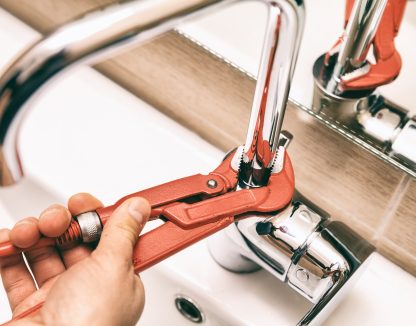In the highly competitive HVAC industry, strategic pricing is the linchpin for achieving both profit maximization and sustainable growth. While flat rate pricing has gained popularity, it’s crucial for HVAC businesses to explore and understand various pricing models to tailor strategies that suit their unique needs. In this HVAC Pricing Guide, we’ll delve into the pros and cons of common pricing models, guide you through calculating labor and material costs, discuss average markup, and reveal strategies for setting competitive prices based on your locality and competition. Additionally, we’ll shed light on the often overlooked but immensely valuable aspect of maintenance agreements and their monetary impact on HVAC businesses.
Common HVAC Pricing Models
There are two primary pricing models that HVAC contractors typically use when pricing their jobs.
Time and Materials (T&M):
Time and materials pricing takes into consideration the time the job takes to complete, the materials you used, and the contractor’s hourly rate. You then add a markup to your materials, and to the total cost, to get your final price.
Here’s how time and materials pricing is typically calculated:
Total cost = hourly labor rate + (cost of materials x markup) + overhead + profit
Pros: Pricing by the hour shows the customer exactly what they’re paying for and allows you to pay the technicians for their work.
Cons: Time and materials pricing is difficult to quote upfront since you aren’t sure exactly how long the job will take. It also leaves room for client disputes, as the longer it takes the technician to complete the job, the higher the cost will be for the homeowner.
Flat Rate Pricing
When using flat rate pricing, you set a fixed price for the job no matter how long it takes. The flat rate price accounts for things like materials used but won’t include line items for hours worked on the final invoice.
Pros: Flat rate pricing means prices are both simple quantities that can help you attract customers who value transparency and are predictable. This model also makes it easier for businesses to manage their prices and keep track of their profits.
If you use flat rate pricing, flat rate rewards work. The faster the technician completes the job, the more money you are making.
Cons: One con of flat rate pricing is customers may become suspicious of the service if they are unable to see line items for materials and labor. You can also potentially lose revenue and profits if the company undercharges for its service and jobs begin taking longer than anticipated.
Regardless of which pricing model you choose, it’s important to understand a few key pieces of your business such as material costs, overhead, labor rates, local competition pricing, and even your marketing costs and expenses. Considering these elements when setting prices will help you understand exactly what you need to charge to make a profit. So how do you calculate some of these key elements?
Calculating Job Costs
Knowing how much you need to spend helps you cover those costs and turn a profit with your pricing. Your costs can be divided into three categories: labor, materials, and overhead.
Determine your HVAC labor rates
Your labor rate is also known as how much you pay yourself, your contractors, subcontractors, or employees for a job. You should factor this number into your estimates no matter which pricing model you choose to ensure you are paid for your work.
Here’s how you can calculate your total labor cost for a job:
Labor hours x hourly labor cost
- To calculate labor hours: Multiply the time spent on a job by the number of techs you need on the job. (E.g., 2 hours x 2 people = 4 hours)
- To calculate your hourly labor cost: Add up each HVAC technician’s hourly salary, plus taxes, workers’ compensation, and any other employee-related expenses. 20–30% is a reliable markup for an hourly labor cost. (E.g., $22 + 20% = $26.40)
- When you multiply your labor hours by your hourly labor cost, you’ll get a total labor cost you can add to your final cost estimate. (4 x 26.40 = $105.60)
Calculating Materials Costs
Material costs include the supplies you need to complete a job. This might be equipment, replacement parts, or even new HVAC tools.
Once you have a clear scope of the work, you’re ready to calculate the cost. To do this:
- List all the materials you need for the job
- Add the cost of each material
- Add markup to each material cost
- Adding markup to new materials you purchase helps you offset overhead costs without cutting wages or adding huge hourly labor rates to your HVAC estimates.
Need help with the markup? The average markup on HVAC equipment is between 25 and 50%, and 100% or higher for spare HVAC parts and materials.
Factor in taxes
To cover your business taxes, add them in when you’re charging for HVAC work. You have two options when it comes to quoting your customers for your HVAC services:
- Include taxes in your pricing
- Charge taxes separately on each invoice
Most businesses choose to list taxes as a separate line item on each quote or invoice because it’s easier to calculate and manage. That means setting a specific price for a service, like $80 to repair a flame sensor, and then charging taxes on top of it.
Research Competitor Pricing
Understanding your competitors is key to winning in the marketplace, but that is especially true regarding price. Consumers are price-sensitive and will always search around to compare quotes. Conducting a market analysis to understand what your competitors are charging is important in setting yourself up for success.
To conduct a proper competitive analysis there are a few key steps.
1. Identify your competitors
The first step is to truly identify your customers. You likely know a few names off the top of your head. Validate that by doing a quick online search of companies in your area. Determine the services you offer and if you have different competitors in each area of your business.
2. Understand their pricing models
The price analysis is the most important piece of this process. One of the main reasons to analyze the competition is to optimize your prices for the market; it’s a huge advantage to know how they price and understand why.
You can do this by simply calling or requesting quotes online. It’s important to do this locally, as pricing varies region by region. In addition to looking at their pricing, evaluate the services offered, size of the business, and age of the business.
Ideally, your competitors will have some information online that will be useful for finding their pricing structure. You can also do this by simply calling or requesting a quote online.
The goal of this step isn’t to just know their prices and then price your jobs lower than theirs. A lower price isn’t always a winning price.
Instead, the goal is to understand how they price. Do they price aggressively online? Do they reprice regularly? Do they run frequent promotions? Are they deceptive in their pricing? These insights will help you create your own data-driven pricing strategies.
Market rates change and as HVAC businesses grow, more established businesses may need to charge more due to more equipment or staff. If you’re just starting, don’t price yourself out of the market – stay somewhere in the middle until you get up and running.
3. Read customer reviews
Are customers happy with the services your competitors offer? How about their experience with the sales staff and technicians on-site? Understanding this aspect can help you identify other aspects of your own company that might be worth a higher price. Does exceptional customer service warrant a higher price? That is something you can explore as you are researching.
4. Compare your websites and offerings
As you are evaluating your competitors, note what you say about yourself online compared to them. What are things that set your business apart? Is that displayed online? Do you offer additional services that they may not? These are all things that can help you set a fair, and attractive price for your customers.
“We have not been super profitable in the last several years although we are busier than ever. Not a lot was making sense until Payzerware!
Now we can see our weak points and because of the integrated flat rate price book we can see that we have not been charging customers nearly enough.
We have been increasing our prices and NOT ONE customer has complained. By year-end we are on track to have the most profitable year to date and I am sure that next year will be even better!”
– Busy Bee Services
Ready to Learn More?
It’s important to remember – don’t feel like you can never change your prices, however. Continue to explore your profits, and how you are priced, making changes as needed.
Understand Your Value Proposition
Highlight unique selling points and differentiate your services from the competition. Your customer service, expertise, and services offered should back up the price you charge – feel confident in this!
If you offer services and products that are more high-end, it makes sense that you would be priced higher than the competition selling a lower-end system.
Consider Pricing and Upsells
Selling to existing customers generates more revenue for your business at a lower cost than finding new customers!
Upselling services can help you:
- Maximize profits with existing customers
- Provide additional value to your customers
- Increase your customer satisfaction
Common examples of HVAC Upsells
There are a few common services to offer your customers that provide value to the homeowner and provide an upsell opportunity for you.
Air Duct Cleaning and Sealing: This is one of the most common HVAC services to upsell. Over time, dust, allergens, and debris can accumulate in HVAC ducts, affecting the longevity of the system itself and affecting indoor air quality. Upselling air duct cleaning and sealing services to your customers not only improves the air they breathe but also enhances system performance. Showcasing the benefits of cleaner air to homeowners will encourage them to opt for this service.
Smart and Programmable Thermostats: In today’s world, smart home technology is more prevalent than ever, and adding smart and programmable thermostats to your offerings allows you to upsell attractive products to your customers.
Wi-Fi-enabled thermostats enable convenience and energy-savings which is important to many homeowners.
Programmable thermostats allow control over the temperature in the home and help save energy, and costs, by setting certain times that temperatures will change.
Presenting and Selling Upsells
Using HVAC proposal software allows you to present upsells on every job, increasing your overall closing rate on the offers, and total revenue.
You can easily add upsells as line items and allow the homeowner to accept or decline the upsells before converting to an invoice.
Special Pricing for Maintenance Agreements
Do you offer maintenance agreements? Something to consider is offering discounted or special pricing for maintenance agreements. Maintenance agreements provide recurring revenue for your business, predictable revenue streams, increased customer retention, and reduced marketing costs.
Your maintenance agreement customers become your new leads. As their systems need to be replaced, you will be their first call and get their business for the replacement unit.
In the dynamic world of HVAC, mastering pricing strategies is the key to thriving amidst competition and achieving sustainable growth. By understanding and implementing various pricing models, calculating labor and material costs accurately, determining competitive pricing based on market analysis, and recognizing the immense value of maintenance agreements, HVAC businesses can maximize profits while fostering long-term customer relationships. Embrace this comprehensive HVAC Pricing Guide as your roadmap to success in a rapidly evolving industry.







